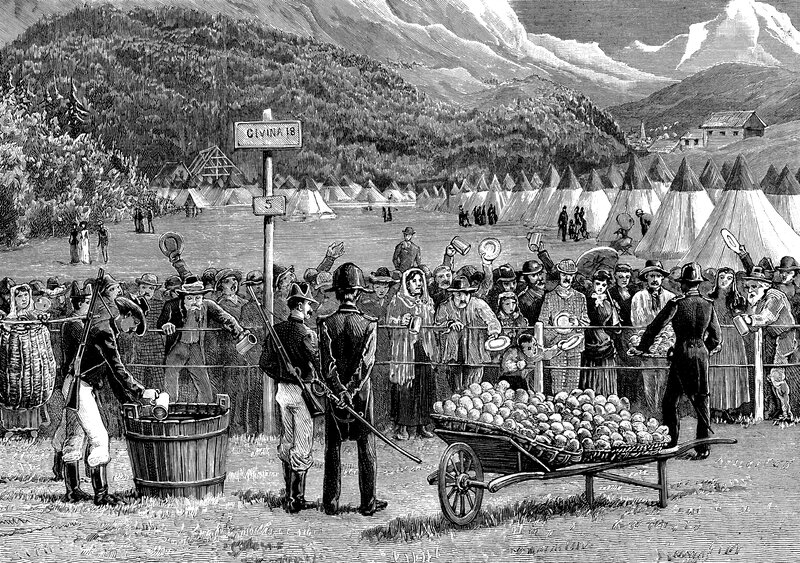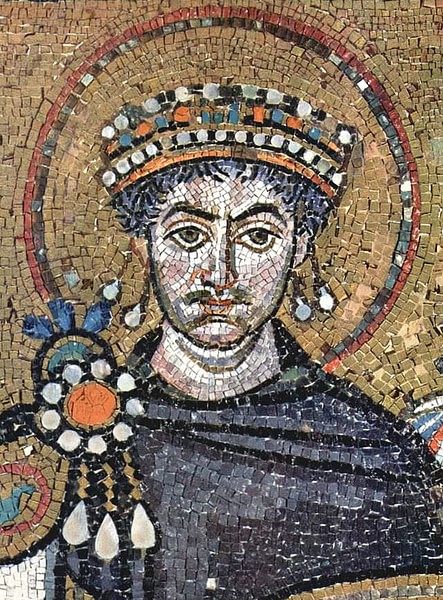A History Of Quarantines From Bubonic Plague To Typhoid Mary
- 'A History of Quarantines From Bubonic Plague To Typhoid Mary,' NPR, Jan. 26, 2020.
China is building a quarantine center on the outskirts of the city of Wuhan, where a newly identified virus has infected many hundreds of residents.
The idea of putting a possibly sick person in quarantine goes back to the ancient texts. The book of Leviticus tells how to quarantine people with leprosy. Hippocrates covered the issue in a three-volume set on epidemics, though he came from a time in ancient Greece when disease was thought to spread from "miasmas," or foul-smelling gas that came out of the ground.
With this new quarantine effort in the news, we offer a look at quarantine use — and abuse — over the ages.
- Bubonic plague in Venice (1370)
The so-called Black Death killed 20 million Europeans in the 14th century. So Venice, a major trade port, grew nervous. If a ship was suspected of harboring plague, it had to wait 40 days before any passengers or goods could come ashore. Venice built a hospital/quarantine center on an island off its coast, where sailors from plague-infested ships were sent either to get better, or, more likely, to die. This 40-day waiting period became known as quarantinario, from the Italian word for 40. As opinions about the disease changed, the isolation period shrank to trentinario — 30 days — but the original name stuck.
- Yellow fever in Philadelphia (1793)
Almost 5,000 people died over the course of two years, about a tenth of the city's population. Thousands fled for the countryside, and at the height of the epidemic, when nearly 100 people were dying every day, the city government collapsed. Philadelphia was the capital of the country, but the federal government evacuated rather than face the scourge. The best known cure at the time was to "bleed" patients of infected blood and give them wine — and a popular theory on stopping the disease was to quarantine sailors at the Lazaretto, a hospital outside the city. But the disease is spread through mosquitoes, so quarantine was not as effective as the cold snap that eventually killed the infected insects.
- Typhus in New York (1892)
In 1892, a boat carrying many Russian Jewish immigrants arrived at Ellis Island. Passengers in steerage class had developed such bad cases of body lice that the harbor inspector declared he had "never seen a more bedraggled group," according to medical historian Howard Markel. Lice led to typhus, but by the time that disease was discovered, the passengers had spread out to boarding houses and family homes across New York's Lower East Side. At least 70 were rounded up and quarantined in tents on North Brother Island in the East River. An outbreak of cholera followed in New York, from a ship bringing more Russian Jewish immigrants. According to Markel, the front page of The New York Times ran a piece saying, "We don't need this kind of riff-raff on our shores," referring to Russian Jews. It wasn't an op-ed, he notes...
https://www.npr.org/sections/goatsandsoda/2020/01/26/799324436/a-history-of-quarantines-from-bubonic-plague-to-typhoid-mary

- In the 1890s, travelers from Switzerland were quarantined in Italy to make sure they didn't have cholera.
____________________
- Named after the Byzantine emperor Justinian I, Justinian’s plague affected nearly half the population of Europe -
- JUSTINIAN's PLAGUE: During the reign of the emperor Justinian I (527-565 CE), one of the worst outbreaks of the plague took place, claiming the lives of millions of people. The plague arrived in Constantinople in 542 CE, almost a year after the disease first made its appearance in the outer provinces of the empire. The outbreak continued to sweep throughout the Mediterranean world for another 225 years, finally disappearing in 750 CE.
Plague Origination & Transmission: Originating in China and northeast India, the plague (Yersinia pestis) was carried to the Great Lakes region of Africa via overland and sea trade routes. The point of origin for Justinian’s plague was Egypt. The Byzantine historian Procopius of Caesarea (500-565 CE) identified the beginning of the plague in Pelusium on the Nile River’s northern and eastern shores. According to Wendy Orent, author of Plague, the disease spread in two directions: north to Alexandria and east to Palestine.
The means of transmission of the plague was the black rat (Rattus rattus), which traveled on the grain ships and carts sent to Constantinople as tribute...https://www.ancient.eu/article/782/justinians-plague-541-542-ce/

- Justinian I, Byzantine Emperor
virgogal
(10,178 posts)No hospital beds available because of the war.
appalachiablue
(41,171 posts)doctor and newly married helping out with the Spanish Influenza epidemic in 1918. Awful. And later scares of polio also.
virgogal
(10,178 posts)I have no idea why it was always in the summer.🤔
appalachiablue
(41,171 posts)and longer daylight hours. As well as hot weather impacting sanitation, otherwise I don't know why there were polio peaks in summer as also mentioned in CDC info. The year 1916 was a big one for polio in the US, what my grandfather no doubt remembered.
- (Wiki). Polio Epidemics: Major polio epidemics were unknown before the 20th century; localized paralytic polio epidemics began to appear in Europe and the United States around 1900.The first report of multiple polio cases was published in 1843 and described an 1841 outbreak in Louisiana. A fifty-year gap occurs before the next U.S. report—a cluster of 26 cases in Boston in 1893. The first recognized U.S. polio epidemic occurred the following year in Vermont with 132 total cases (18 deaths), including several cases in adults. Numerous epidemics of varying magnitude began to appear throughout the country; by 1907 approximately 2,500 cases of poliomyelitis were reported in New York City.

- This cardboard placard was placed in windows of residences where patients were quarantined due to poliomyelitis. Violating the quarantine order or removing the placard was punishable by a fine of up to US$100 in 1909 (equivalent to $2,846 in 2019).
- Polio was a plague. One day you had a headache and an hour later you were paralyzed. How far the virus crept up your spine determined whether you could walk afterward or even breathe. Parents waited fearfully every summer to see if it would strike. One case turned up and then another. The count began to climb. The city closed the swimming pools and we all stayed home, cooped indoors, shunning other children. Summer seemed like winter then. - Richard Rhodes, A Hole in the World -
On Saturday, June 17, 1916, an official announcement of the existence of an epidemic polio infection was made in Brooklyn, New York. That year, there were over 27,000 cases and more than 6,000 deaths due to polio in the United States, with over 2,000 deaths in New York City alone...https://en.wikipedia.org/wiki/History_of_polio
pansypoo53219
(20,995 posts)+ churches. but only a handful died. maybe 3 people.
3Hotdogs
(12,406 posts)There were degrees of disability. Oldest girl ended up with braces, crutches and so forth. Oldest boy recovered to be a state competitor for mile race in track.
Some shit.
We were all grateful when the vaccine was released.
appalachiablue
(41,171 posts)of the vaccine. I knew two kids a bit older who had it, a boy with an affected arm and a girl with one lower leg impacted. This is a good, long Wiki list, I never knew about all the people with polio, amazing.
https://en.wikipedia.org/wiki/List_of_polio_survivors